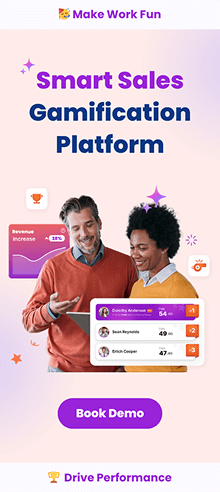Gamification Strategies Can You Implement?
Sales gamification transforms everyday sales tasks into engaging activities by incorporating elements typically found in games, such as competition and rewards. This innovative approach leverages our intrinsic love for games to bolster sales performance, infusing a sense of excitement and urgency into the sales process.
By tapping into the competitive spirit and desire for achievement, gamification motivates teams, propelling them towards their targets with increased vigor.
In this article, you’ll discover a range of innovative sales gamification strategies that can dramatically enhance your team’s engagement and productivity. You will also find creative ways to elevate your sales gamification efforts, ensuring your strategies remain fresh and effective. Whether you’re looking to kickstart a new gamification initiative or optimize an existing one, the insights here will guide you in creating a more dynamic and motivating sales environment.

Understanding Sales Gamification
Sales gamification is the use of game mechanics and design techniques in a sales context to motivate and engage sales teams. This strategy turns traditional sales activities into more interactive and enjoyable processes. By adding elements of competition, achievement, and recognition to the daily workflow, sales gamification encourages employees to reach and exceed their goals.
Here’s what you need to know about sales gamification:
- Encourages Behavior: Sales gamification uses people’s natural instincts for competition and achievement to motivate desired actions among sales reps.
- Tracks Performance: It provides real-time monitoring of performance metrics, allowing sales teams to see how they’re doing compared to their targets and colleagues.
- Improves Engagement: Taking part in gamified elements makes the selling process more fun, which can result in higher job satisfaction and lower employee turnover.
- Rewards Achievements: Acknowledging successes with rewards, whether virtual (like badges or points) or physical (such as bonuses or prizes), encourages even more motivation.
By transforming sales goals into challenges to overcome or levels to reach, you give your team a sense of purpose and enjoyment. This not only makes achieving targets less intimidating, but it also creates an environment where continuous growth is valued and acknowledged.
The Power of Gamification in Sales: Key Benefits
Investing in sales gamification offers many advantages that can transform a business’s sales force. Here are some key benefits of sales gamification:
1. Increased Employee Motivation
By incorporating game-like elements such as scoring, competitions, and rewards, sales teams experience renewed motivation. Gamification taps into intrinsic motivators, driving sales reps to push their boundaries and strive for excellence in their roles.
2. Improved Productivity
When sales tasks are gamified, the mundane becomes exciting. This shift in perception can lead to higher levels of engagement with daily activities, ultimately boosting productivity as reps work harder to meet and surpass targets.
3. Enhanced Collaboration
Gamification often includes team-based challenges which require collaboration among team members. This aspect fosters a sense of camaraderie and encourages knowledge sharing, which is beneficial for the entire organization.
By harnessing these benefits, businesses not only amplify their sales results but also create an environment where employees are eager to contribute to the company’s success. With increased motivation and productivity coupled with enhanced collaboration, the stage is set for implementing innovative strategies that further elevate the effectiveness of gamification in sales environments.
Innovative Strategies to Level Up Your Sales Gamification Efforts
The competitive spirit in sales departments is a crucial motivator, but without the right tools and strategies, it can quickly fizzle out. Innovative sales gamification strategies harness this spirit by introducing fresh and engaging methods to drive performance. Leaderboards in sales gamification and progress bars in sales gamification are two such dynamic tools that have revolutionized how teams track success and stay motivated.
Leaderboards and Progress Bars
Dynamic Leaderboards
Leaderboards tap into the inherent competitive nature of sales professionals. With a real-time display of performance metrics, they ignite a fire under team members, pushing them to ascend the ranks. Here’s why dynamic leaderboards are indispensable:
- Visibility: They provide immediate feedback on where individuals or teams stand, offering visibility that can spur on-the-spot motivation.
- Recognition: Through regular updates, top performers gain recognition for their efforts, which bolsters their drive to maintain or improve their ranking.
- Benchmarking: Sales reps can benchmark their performance against peers, setting personal goals to strive for improvement.
Progress Bars
In the pursuit of goals, tracking progress is paramount. Progress bars serve as visual cues that break down larger targets into manageable milestones. These bars offer several benefits:
- Clarity: They simplify complex sales targets into clear, incremental steps, making objectives seem more attainable.
- Momentum: As reps see the bar fill up, there’s a palpable sense of momentum building towards goal completion.
- Motivation: Visual progress instills a sense of accomplishment and fuels the desire to push forward until the final objective is met.
By integrating these elements into your sales strategy, you create an environment where achievements are not just recognized but celebrated visually and in real-time. This not only helps maintain high energy levels across your sales floor but also fosters a culture of continuous improvement and success.
When applied correctly, innovative gamification strategies like leaderboards and progress bars transform routine sales activities into engaging challenges that reps will be eager to take on. These tools are not merely about tracking; they’re about creating an immersive experience that resonates with the innate human desire for achievement and acknowledgment.
As you consider incorporating these strategies into your own operations, remember that their success hinges on thoughtful implementation that aligns with your organization’s culture and sales goals. In the following sections, we delve deeper into additional tactics such as badges, achievements, levels, and how they can further enhance your gamification efforts.
2. Badges, Achievements, and Levels
In the world of creative sales gamification strategies, using badges, achievements, and levels is a powerful way to acknowledge and motivate sales teams. These elements act as visible symbols of success that inspire individuals to aim for better performance.
Badges in Sales Gamification
Badges are great for celebrating achievements in a visual and shareable manner. They can be customized based on different levels of expertise or accomplishments. For instance:
- The Trailblazer Badge: Given to reps who successfully close deals with new clients.
- The High-Five Badge: Awarded to those who exceed their weekly targets.
- The Connector Badge: Earned by individuals who excel at generating referrals.
Achievements in Sales Gamification
Achievements are more than just one-time actions; they recognize ongoing efforts or significant milestones. Here are a few examples:
- Quarter Quota Crusher: Acknowledging reps who meet their monthly quota every month of the quarter.
- The Comeback Kid: Recognizing an impressive recovery from a performance slump.
Levels in Sales Gamification
Moving up through different levels creates a sense of professional growth within the gamified system. Advancing levels could be based not only on sales numbers but also on soft skills and customer satisfaction ratings.
By incorporating these innovative sales gamification strategies into your framework, you actively engage your team with rewards that resonate on a personal level while driving business outcomes. As you consider integrating badges, achievements, and levels into your sales strategy, keep them aligned with clear, achievable goals to ensure they reinforce desired behaviors and contribute positively to your sales culture.
3. Gamified Learning Modules and Simulations
Engaging sales teams in continuous learning and development is crucial, and gamified learning modules in sales gamification are an effective way to achieve this. By incorporating interactive quizzes, you turn the acquisition of new knowledge into a compelling challenge. Sales representatives can test their understanding of product details, sales tactics, and customer service skills in a dynamic format that encourages retention.
Role-playing simulations take this a step further by allowing reps to practice real-world scenarios in a controlled, competitive environment. These simulations in sales gamification not only refine sales techniques but also build confidence. Here’s how:
- Interactive Quizzes: Short, sharp quizzes reinforce training materials and product knowledge. A points system can be used to reward correct answers, encouraging reps to focus and engage with the content.
- Role-Playing Simulations: Reps act out sales scenarios with varying degrees of difficulty. Advanced software allows for these simulations to be recorded and reviewed, offering valuable feedback for improvement.
The use of leaderboards in sales gamification within these modules displays rankings based on quiz scores or simulation performance, while progress bars in sales gamification show individual learning progressions. Together, they create a comprehensive view of where each team member stands in their development journey.
With these innovative sales gamification strategies, you transform traditional training into an exciting part of your team’s everyday routine. The competitive edge stimulated by these methods not only keeps your team sharp but also fosters a culture of continuous improvement and excellence.
4. Real-time Challenges and Rewards
Incorporating real-time challenges in sales gamification taps into a high-stakes environment that can spur your team to new heights. These time-sensitive contests harness the thrill of a ticking clock, compelling sales reps to push their limits and achieve short-term goals with urgency.
Time-Bound Competitions
Quick sprints, such as daily or weekly sales contests, can light a fire under your team, driving them to accelerate their efforts. Use leaderboards in sales gamification to display real-time standings, fueling a dynamic competitive atmosphere.
Spotlight Achievements
Celebrate victories instantly! When a rep closes a big deal or reaches a milestone, acknowledge it then and there. This instant gratification reinforces positive behavior through immediate recognition.
Rewards in sales gamification must be enticing and varied to cater to different motivations:
- Experiential Incentives: Offer rewards that create lasting memories, such as travel vouchers, concert tickets, or unique dining experiences. These prizes often hold more personal value than cash bonuses.
- Personalized Privileges: Tailor rewards to individual preferences. Personalized privileges could include an extra day off, a parking spot closer to the office entrance, or the opportunity to lead a project they’re passionate about.
Implement progress bars in sales gamification as visual cues of advancement towards these rewards, enhancing the sense of achievement as goals are approached and met.
By integrating real-time challenges and diverse rewards into your sales strategy, you nurture an environment where accomplishments are celebrated promptly and success is tangibly within reach for every team member.
5. Using AI and Predictive Analytics to Enhance Gamification
In the world of creative sales gamification techniques, combining AI and predictive analytics brings about a new era of personalized interaction. AI in sales gamification goes beyond traditional one-size-fits-all methods by using data-driven information to create tailored experiences for each sales representative. Here’s how it improves the strategy:
Benefits of AI in Sales Gamification
- Customized Challenges: AI algorithms analyze past performance to suggest attainable yet challenging targets for each team member.
- Predictive Performance Modeling: By harnessing predictive analytics in sales gamification, AI forecasts future sales trends, helping teams prepare and strategize accordingly.
- Dynamic Leaderboards: Beyond static lists, leaderboards in sales gamification become interactive and adaptive, reflecting real-time data and motivating continued excellence.
- Progress Tracking With Precision: Incorporating progress bars in sales gamification provides visual cues that adapt to the pace and rhythm of each salesperson’s progress.
Through the use of these advanced technologies, businesses can not only stay ahead of the game but also ensure that their gamification strategies are as effective and engaging as possible. This approach allows for a deeper understanding of individual and team dynamics, making sure that every member feels valued and motivated by challenges that are perfectly suited to their skills and growth potential.
The Power of Integration
The integration of AI not only streamlines operations but also delivers a richer, more immersive gamification experience. With the ability to analyze vast amounts of data quickly and accurately, AI can provide valuable insights into individual performance, identify areas for improvement, and offer personalized recommendations for skill development.
By leveraging these insights, sales managers can:
- Provide targeted coaching and training opportunities
- Identify top performers for recognition and rewards
- Implement strategies to boost motivation and engagement
- Optimize resource allocation and goal setting
With a highly motivated sales force equipped with actionable insights, businesses can not only meet but exceed their targets.
Key Considerations for Implementing Successful Sales Gamification Strategies
When implementing sales gamification strategies, it is vital to ensure that they are not only engaging but also effective in driving the desired business outcomes. Below are some key considerations to keep in mind:
1. Alignment with Business Goals
Each element of your gamification strategy should support overarching business objectives. Whether it’s increasing sales, improving lead quality, or enhancing customer satisfaction, games and contests need to contribute directly to these targets.
2. Balance Between Competition and Collaboration
While competition is a significant motivator, it’s crucial to foster a team environment where collaboration is equally recognized. This can be achieved by incorporating team-based challenges and shared rewards that require collective effort.
3. Regular Evaluation of Strategy Effectiveness
To ensure the long-term success of your gamification efforts, establish metrics for regular assessment. This involves tracking participation rates, employee feedback, and performance data to refine and improve the strategy over time.
These considerations serve as a framework for creating a robust sales gamification plan that resonates with employees and aligns with company growth aspirations. Moving forward, exploring the right tools becomes the next critical step in operationalizing these strategic elements into daily sales activities.
Choosing the Right Sales Gamification Software
When choosing sales gamification software, it’s important to find options that meet your team’s needs and align with your business goals. Here are some key features to look for when making your decision:
Essential Features to Consider
- Real-Time Analytics: The software should provide instant tracking of sales performance, allowing for immediate feedback and adjustments.
- Customization Options: Look for platforms that let you customize games and challenges to fit your company’s culture and sales targets.
- Integration Capabilities: It’s crucial that the software can easily integrate with your current CRM system and other sales tools, ensuring smooth operations.
- User-Friendly Interface: A simple and easy-to-use interface will encourage more sales reps to actively participate in the gamification activities.
- Mobile Accessibility: Since sales teams are often on the go, having mobile support is essential for them to be able to participate anytime, anywhere.
Recommendations Based on Budget and Business Size
Here are some recommendations based on different budget levels and sizes of businesses:
- For Small Businesses:
- Choose affordable solutions that offer basic gamification features such as leaderboards and challenges.
- For Midsize Companies:
- Consider software with more advanced customization options and integration capabilities that can grow together with your expanding team.
- For Large Enterprises:
- Invest in comprehensive platforms that come with AI-powered insights, extensive analytics, and strong support services.
By focusing on these key features, businesses of any size can find a sales gamification tool that not only motivates their team but also delivers measurable results.
Getting Started with Gamification: Best Practices for Sales Teams
Implementing gamification in your sales processes can transform the way your team achieves targets. To ensure a fruitful introduction of gamification concepts, consider these actionable tips:
1. Define Clear Objectives
Before introducing any game mechanics, establish what you aim to achieve. Whether it’s increasing cold calls or boosting the average deal size, set specific, measurable goals.
2. Educate Your Team
Ensure that every member understands how gamification works and its benefits. Conduct training sessions to elucidate how various activities will be tracked and rewarded.
3. Select Appropriate Rewards
Motivation varies among individuals. Offer a variety of rewards that cater to different preferences, from monetary incentives to additional time off or public recognition.
4. Customize Challenges
Not all sales reps are at the same level. Craft challenges that are attainable for newcomers yet still engaging for seasoned veterans.
5. Encourage Collaboration
While competition can be motivating, teamwork should also be celebrated. Consider implementing team-based challenges to foster a collaborative environment.
6. Leverage Software Tools
Utilize robust gamification software that allows you to track performance, set up competitions, and automate reward distribution.
7. Gather Feedback Regularly
Sales team best practices gamification strategies benefit greatly from regular feedback. Solicit opinions from your team about what’s working and what could be improved.
By incorporating these practices into your sales strategy, you create an environment where gamification thrives, leading to higher engagement and performance from your sales team.
Innovate to Elevate: Your Blueprint for Personalized Sales Gamification
Use innovation and creativity to create sales gamification strategies that align with your team’s dynamics and organizational goals. Remember, the combination of competition, recognition, and immediate rewards can greatly enhance sales performance. Keep these key principles in mind:
- Personalization: Customize gamification elements to suit your team’s unique culture and preferences.
- Measurable Outcomes: Create strategies that connect game mechanics to measurable sales metrics.
- Continuous Improvement: Adjust and improve your strategies based on feedback and performance data.
Challenge yourself to think creatively and develop innovative sales gamification strategies that not only inspire but also bring a new energy to achieving sales targets. Embrace this opportunity to transform the sales process into an interactive and fulfilling journey.



